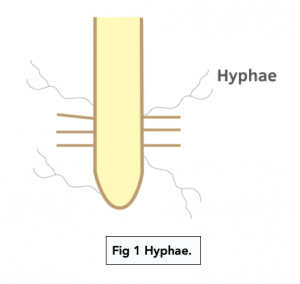Introduction to Nutrient Cycles (A-level Biology)
Introduction to Nutrient Cycles
Natural Ecosystems
Natural ecosystems are those unchanged by human interference.
In natural ecosystems, nutrients are converted into reusable material through food webs by microorganisms (bacteria and fungi).
Organic material is broken down so it’s chemical elements can be re-used by other organisms, for example:
- Nitrogen is broken down to make amino acids and proteins, as well as nitrogenous bases in DNA.
- Phosphorus is broken down to make ATP, DNA and phospholipids (component of cell membranes).
We will explore these cycles in more detail over the next few sections.
Saprobionic Nutrition
Saprobionts are a type of decomposer; they digest dead organisms externally by secreting enzymes and then absorb the useful products.
Larger organic molecules are broken down into smaller inorganic molecules during this process (this is important for the nitrogen cycle).
Mycorrhizae
Mycorrhizae are a type of symbiotic relationship (where each organism benefits from the other) formed between fungi and the roots of plants.
- The benefit to the plant is the increased surface area of the roots – used to increase the absorption of water and mineral ions (phosphate ions) from the soil.
- The benefit to the fungi is the organic compounds, such as glucose, that the plant provides.
The fungi consist of hyphae – long, filamentous structures that connect to the plants roots and extend into the soil.

Nutrient cycles refer to the continuous movement of nutrients from the environment, through living organisms, and back to the environment. The cycles involve the transformation of these nutrients from one form to another as they are taken up, used, and released by different organisms.
Nutrient cycles play a crucial role in maintaining the balance of the ecosystem. They ensure that essential nutrients, such as carbon, nitrogen, and phosphorus, are constantly available to support the growth and reproduction of all living organisms. Without nutrient cycles, these essential elements would become depleted, leading to a decline in biodiversity and a disruption of the ecosystem as a whole.
There are three main types of nutrient cycles: the carbon cycle, the nitrogen cycle, and the phosphorus cycle. These cycles are interdependent, and changes in one cycle can impact the other two.
Yes, humans can have a significant impact on nutrient cycles. For example, deforestation and the burning of fossil fuels can alter the carbon cycle, while agricultural practices, such as the use of nitrogen-based fertilizers, can impact the nitrogen cycle. These changes can lead to an increase in greenhouse gas emissions, soil degradation, and water pollution, among other issues.
To help maintain the balance of nutrient cycles, it is important to reduce human activities that contribute to the alteration of these cycles. This can include reducing deforestation, reducing the use of nitrogen-based fertilizers, and promoting sustainable agricultural practices. Additionally, it is important to increase awareness about the importance of nutrient cycles and their impact on the environment.





Still got a question? Leave a comment
Leave a comment